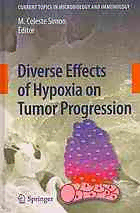
Diverse effects of hypoxia on tumor progression PDF
Preview Diverse effects of hypoxia on tumor progression
M. Celeste Simon Editor Diverse Effects of Hypoxia on Tumor Progression Editor M.CelesteSimon,PhD UniversityofPennsylvania SchoolofMedicine 19104-6160Philadelphia Pennsylvania USA [email protected] ISSN0070-217X ISBN:978-3-642-13328-2 e-ISBN:978-3-642-13329-9 DOI10.1007/978-3-642-13329-9 SpringerHeidelbergDordrechtLondonNewYork LibraryofCongressControlNumber:2010934929 #Springer-VerlagBerlinHeidelberg2010 Thisworkissubjecttocopyright.Allrightsarereserved,whetherthewholeorpartofthematerialis concerned,specificallytherightsoftranslation,reprinting,reuseofillustrations,recitation,broadcasting, reproductiononmicrofilmorinanyotherway,andstorageindatabanks.Duplicationofthispublication orpartsthereofispermittedonlyundertheprovisionsoftheGermanCopyrightLawofSeptember9, 1965,initscurrentversion,andpermissionforusemustalwaysbeobtainedfromSpringer.Violations areliabletoprosecutionundertheGermanCopyrightLaw. Theuseofgeneraldescriptivenames,registerednames,trademarks,etc.inthispublicationdoesnot imply,evenintheabsenceofaspecificstatement,thatsuchnamesareexemptfromtherelevantprotec- tivelawsandregulationsandthereforefreeforgeneraluse. Coverdesign:WMXDesignGmbH,Heidelberg,Germany Printedonacid-freepaper SpringerispartofSpringerScience+BusinessMedia(www.springer.com) Preface Solidtumorsfrequentlycontainareasofoxygendeprivation(hypoxia)duetorapid cell proliferation and/or vascular insufficiency. The presence of hypoxic domains typically correlates with poor patient prognosis, due to the relative resistance of hypoxic cells to conventional cancer therapies and effects of O availability on 2 diseaseprogression.Theresponseofmalignantcellstohypoxiahasbeenthefocus of intense research over the last decade. In this issue of Current Topics in Micro- biologyandImmunology,wepresentchaptersdescribingtheimpactofhypoxiaon components of the tumor microenvironment (such as endothelial cells, inflamma- torycells,andtumor-associatedfibroblasts),theexpressionofuniquemicroRNAs, tumorcelldifferentiationstatus,andmetastasis.Eachreviewchapterdescribesthe stateofthefieldstudyingthesetopicsandposesimportantquestionsforthefuture. Theoverallgoalistodepicttumorphenotypesandassociatedmolecularpathways tobeexploitedinthedevelopmentofnoveltherapeuticstobeusedagainstabroad spectrumofhumancancers. Summer2010 CelesteSimon v . Contents TheHIF-2a-DrivenPseudo-HypoxicPhenotypeinTumor Aggressiveness,Differentiation,andVascularization ....................... 1 AlexanderPietras,A.SofieJohnsson,andSvenPa˚hlman HypoxiaandHypoxiaInducibleFactorsinCancerStem CellMaintenance .............................................................. 21 ZhizhongLiandJeremyN.Rich RoleofCarcinoma-AssociatedFibroblastsandHypoxiainTumor Progression .................................................................... 31 AmatoJ.GiacciaandErnestinaSchipani TheRoleofHypoxiaRegulatedmicroRNAsinCancer .................... 47 RobertMcCormick,FrancescaM.Buffa,JiannisRagoussis, andAdrianL.Harris OxygenSensing:ACommonCrossroadinCancer andNeurodegeneration ....................................................... 71 AnneliesQuaegebeurandPeterCarmeliet Hypoxia-InducibleFactorsasEssentialRegulatorsofInflammation .... 105 HongxiaZ.ImtiyazandM.CelesteSimon HypoxiaandMetastasisinBreastCancer ................................. 121 HeleneRundqvistandRandallS.Johnson Index .......................................................................... 141 vii . Contributors Francesca M. Buffa Molecular Oncology Laboratories, Weatherall Institute of Molecular Medicine, University of Oxford, John Radcliffe Hospital, Oxford OX3 9DS, UK PeterCarmeliet VesaliusResearchCenter(VRC),VIB,K.U.Leuven,Campus Gasthuisberg, Herestraat 49, 3000 Leuven, Belgium, peter.carmeliet@ vib-kuleuven.be Amato J. Giaccia Department of Radiation Oncology, Division of Cancer and Radiation Biology, Stanford University School of Medicine, Stanford, CA 94305-5152, USA, [email protected] Adrian L. Harris Molecular Oncology Laboratories, Weatherall Institute of Molecular Medicine, University of Oxford, John Radcliffe Hospital, Oxford OX3 9DS, UK, [email protected] Hongxia Z. Imtiyaz Abramson Family Cancer Research Institute, Univer- sity of Pennsylvania, 438 BRB II/III, 421 Curie Boulevard, Philadelphia, PA 19104-6160,USAandHowardHughesMedicalInstitute,Chevy Chase,MD, USA, [email protected] Randall S. Johnson Molecular Biology Section, Division of Biological Sciences, University of California, San Diego, CA 92093, USA, rjohnson@ biomail.ucsd.edu A. Sofie Johnsson Department of Laboratory Medicine, Center for Molecular Pathology, Lund University, University Hospital MAS, Entrance 78, 205 02 Malmo, Sweden Zhizhong Li Department of Radiation Oncology, Duke University Medical Center, Durham, NC 27710, USA ix x Contributors Robert McCormick Molecular Oncology Laboratories, Weatherall Institute of Molecular Medicine, University of Oxford, John Radcliffe Hospital, Oxford OX3 9DS, UK Sven Pahlman Department of Laboratory Medicine, Center for Molecular Pathology, Lund University, University Hospital MAS, Entrance 78, 205 02 Malmo, Sweden, [email protected] Alexander Pietras Department of Laboratory Medicine, Center for Mole- cular Pathology, Lund University, University Hospital MAS, Entrance 78, 205 02 Malmo, Sweden Annelies Quaegebeur Vesalius Research Center (VRC), VIB, K.U. Leuven, Campus Gasthuisberg, Herestraat 49, 3000 Leuven, Belgium JiannisRagoussis MolecularOncologyLaboratories,WeatherallInstituteof Molecular Medicine, University of Oxford, John Radcliffe Hospital, Oxford OX3 9DS, UK Jeremy N. Rich Department of Stem Cell Biology and Regenerative Medi- cine,LernerResearchInstitute,ClevelandClinic,Cleveland,OH44195,USA, [email protected] Helene Rundqvist Molecular Biology Section, Division of Biological Sciences, University of California, San Diego, CA 92093, USA Ernestina Schipani Endocrine Unit, Department of Medicine, MGH- Harvard Medical School, Boston, MA 02114, USA M. Celeste Simon Abramson Family Cancer Research Institute, University of Pennsylvania, 438 BRB II/III, 421 Curie Boulevard, Philadelphia, PA 19104-6160,USAandHowardHughesMedicalInstitute,Chevy Chase,MD, USA and Department of Cell and Developmental Biology, University of Pennsylvania School of Medicine, Philadelphia, PA 19104, USA, celeste2@ mail.med.upenn.edu a The HIF-2 -Driven Pseudo-Hypoxic Phenotype in Tumor Aggressiveness, Differentiation, and Vascularization AlexanderPietras,A.SofieJohnsson,andSvenPa˚hlman Contents 1 Introduction.................................................................................. 2 2 PhenotypicEffectsofHIF-2aElimination.................................................. 3 3 HIF-2DuringNormalSympatheticNervousSystem(SNS)Development.................. 4 4 HypoxiainSolidTumorsandRelationtoTumorAggressiveness.......................... 5 5 DifferentialTumorHIFExpressioninRelationtoPatientOutcome........................ 6 5.1 Neuroblastoma......................................................................... 6 5.2 BreastCarcinoma...................................................................... 7 5.3 RenalCellCarcinoma................................................................. 8 5.4 NonsmallCellLungCarcinoma....................................................... 9 5.5 Glioblastoma ......................................................................... 10 6 HypoxiaandTumorCellDifferentiation...................................................10 7 HIF-2aandTumorInitiating/StemCells...................................................11 8 HIFsandVascularization...................................................................13 9 HIF-2aandthePseudo-HypoxicPhenotype:TargetsforTumorTreatment...............14 References.......................................................................................15 Abstract Cellular adaptation to diminished tissue oxygen tensions, hypoxia, is largelygovernedbythehypoxiainducibletranscriptionfactors,HIF-1andHIF-2. TumorhypoxiaandhighHIFproteinlevelsarefrequentlyassociatedwithaggres- sive disease. In recent years, high tumor cell levels of HIF-2 and the oxygen sensitive subunit HIF-2a have been associated with unfavorable disease and shown to be highly expressed in tumor stem/initiating cells originating from neuroblastoma and glioma, respectively. In these cells, HIF-2 is active under nonhypoxic conditions as well, creating a pseudo-hypoxic phenotype with clear influence on tumor behavior. Neuroblastoma tumor initiating cells are immature with a neural crest-like phenotype and downregulation of HIF-2a in these cells A.Pietras,A.S.Johnsson,andS.Pa˚hlman(*) DepartmentofLaboratoryMedicine,CenterforMolecularPathology,LundUniversity,Univer- sityHospitalMAS,Entrance78,20502Malmo¨,Sweden e-mail:[email protected] M.CelesteSimon(ed.),DiverseEffectsofHypoxiaonTumorProgression, 1 CurrentTopicsinMicrobiologyandImmunology345,DOI10.1007/82_2010_72 #Springer‐VerlagBerlinHeidelberg2010,publishedonline:2June2010 2 A.Pietrasetal. resultsinneuronalsympatheticdifferentiationandthecellsbecomephenotypically similartothebulkofneuroblastomacellsfoundinclinicalspecimens.Knockdown ofHIF-2ainneuroblastomaandgliomatumorstem/initiatingcellsleadstoreduced levels of VEGF and poorly vascularized, highly necrotic tumors. As high HIF-2a expression further correlates with disseminated disease as demonstrated in neuro- blastoma, glioma, and breast carcinoma, we propose that targeting HIF-2a and/or the pseudo-hypoxic phenotype induced by HIF-2 under normoxic conditions has greatclinicalpotential. 1 Introduction Mammalian cells, including tumor cells, require oxygen for maintenance of an efficient energy supply and lack of oxygen eventually leads to cell death due to impaired energy requiring processes. Cells can withstand fluctuations in oxygen levelsbyadaptingtoadecreaseinoxygeninvolvingreductionofenergyconsump- tionandincreaseinanaerobicmetabolism.Duringtheadaptationprocess,thereisa dramaticshiftintheexpressionofgenesregulatinganumberofcellularfunctions includingglucose transportandmetabolism,angiogenesis,andcellsurvival.Cen- tral to this phenotypic shift are the hypoxia inducible factors (HIFs), HIF-1, and HIF-2.Thesefactorsareheterodimerictranscriptionfactorscomposedofaunique alphasubunitandabetasubunit(ARNT/HIF-1b)sharedbyallthreeHIFs.Classi- cally,HIFsareregulatedbydegradationofthealphasubunitathighoxygenlevels and by stabilization at hypoxia (reviewed in Kaelin and Ratcliffe 2008). In the dimeric,activestate,HIF-1andHIF-2bindtohypoxiaresponsiveelements(HREs) locatedingenesregulatedbyhypoxiaandHIFs.AlthoughHIF-1andHIF-2seemto activate hypoxia-responsive genes by similar means (Tian et al. 1997; Wiesener et al. 1998), the HIF-a subunits work in a nonredundant manner and several differences in gene regulation have been proposed, many ofwhich emphasize the predominant role of HIF-1 in regulating the transcriptional response to hypoxia (Iyer et al. 1998; Ryan et al. 1998; Hu et al. 2003; Park et al. 2003; Sowter et al. 2003). As detailed below, HIF-2 is also crucial for the hypoxic response, and as opposedtoHIF-1itisactiveatprolongedhypoxiaaswell(Holmquist-Mengelbier etal.2006).ThelessstudiedHIF-3ispresentinseveralsplicevariantslackingthe C-terminaltransactivationdomainandisthoughttonegativelyregulateHIF-1and HIF-2bysequesteringtheHIF-1andHIF-2alphasubunits,therebyblockingtheir binding to HREs (Makino et al. 2001; Maynard et al. 2007). Although the main modeofHIFactivationisviastabilizationofthealphasubunits,HIF-2,aswellas HIF-1, can be stable and transcriptionally active at physiological or even higher oxygen tensions, as will be the central theme in this review. We propose that this phenomenon, at least regarding HIF-2, is largely linked to its role and regulation duringnormaldevelopment. ThephenotypesobtainedbyeliminationofeitherHif1aorEpas1/Hif2aclearlyshow that both genes are needed for proper development and that they are nonredundant.
